Feroze Shah Kotla Fort
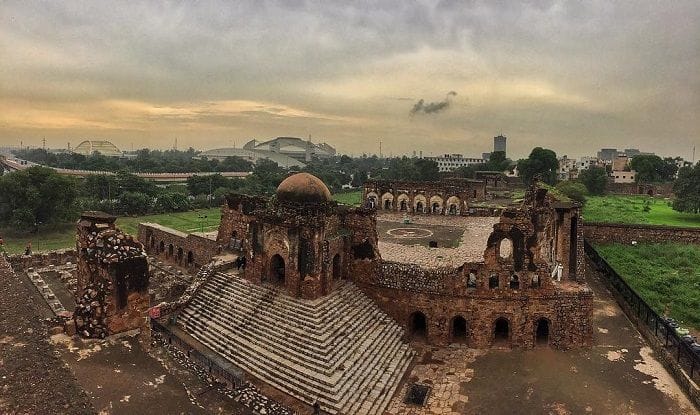
Feroz Shah Kotla Fort is an ancient fortress built by Feroz Shah Tughlaq of the Tughlaq Dynasty as the crown jewel of his new capital city of Firozabad. However, great misfortune continuously befell his capital which eventually forced a shift back to Delhi soon.
History
The history of Feroz Shah Kotla Fort dates back to the 14th century during the reign of Sultan Feroz Shah Tughlaq, the third rule of the Tughlaq Dynasty to serve as the Sultan of Delhi from 1351 to 1388. Feroz Shah, known for his ambitious architectural projects, ordered the construction of the fort in 1354 as part of his grand vision to establish a new capital city, Ferozabad. Known for his ambitious architectural projects and administrative reforms, Feroz Shah took charge of the reigns after the death of his cousin and predecessor, Muhammad bin Tughlaq. He envisioned Ferozabad as a capital city that could rival the grandeur of its predecessors, Delhi and Tughlaqabad.
The site chosen for the fort was strategically located on the eastern banks of the Yamuna River, which had a dual advantage as it served as a natural buffer that could slow the enemy down and also provide easy access to water—a crucial consideration in an era marked by frequent sieges and military campaigns.

The fortification of Feroz Shah Kotla comprised massive walls, bastions, and ramparts constructed using locally sourced red sandstone, a hallmark of Tughlaq architecture. The layout of the fort was meticulously planned, with strategic positioning of gates, towers, and defensive structures to deter potential invaders and safeguard the city's inhabitants. Within the fort complex, Feroz Shah commissioned the construction of palaces, audience halls, mosques, and gardens, transforming it into a thriving urban center.
Despite its grandeur, Ferozabad faced numerous challenges during its brief existence, including financial constraints, political instability, and administrative inefficiencies. The ambitious projects undertaken by Feroz Shah, including the construction of canals, reservoirs, and public works, greatly strained the resources of the empire and alienated the nobility and clergy. Moreover, Ferozabad's strategic location on the frontier had the inadvertent effect of exposing it to frequent raids and incursions by rival kingdoms, further undermining its stability and prosperity.
By the end of Feroz Shah's reign in 1388, Ferozabad had begun to severly decline, plagued by internal strife, external threats, and economic hardships. The subsequent rulers of the Tughlaq dynasty, unable to revive the fortunes of the city, gradually abandoned it in favor of Delhi and other pre-established centers of power. Over time, Ferozabad fell into ruin and obscurity, its magnificent structures succumbing to the ravages of time and neglect.
Despite being left behind, over the centuries, the fort was repurposed and modified by successive rulers, including the Mughals, British, and post-independence governments, each leaving their indelible mark on its storied walls and corridors.
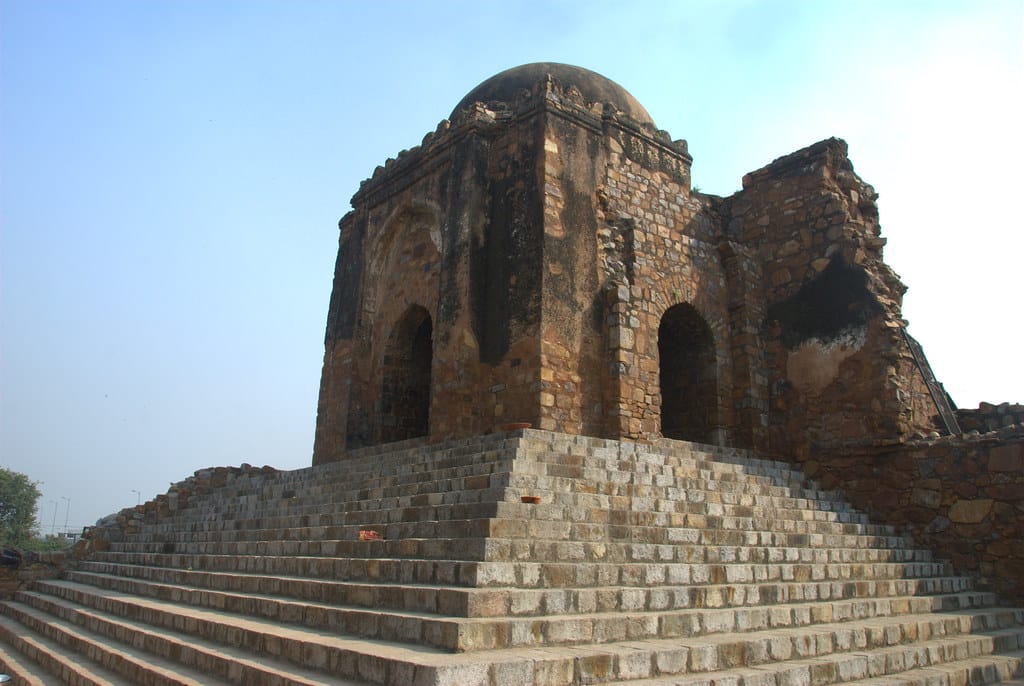
Jami Masjid
One of the most iconic landmarks within Feroz Shah Kotla Fort is the Jami Masjid, also known as the Friday Mosque. Constructed between 1354 and 1388, the mosque is a remarkable example of Islamic architecture, characterized by its grand domes, intricate carvings, and ornate minarets. The Jami Masjid was a place of worship for the residents of Ferozabad, accommodating thousands of devotees during Friday prayers and religious festivals.
The architectural design of the Jami Masjid reflects the aesthetic sensibilities of the Tughlaq period, blending elements of Persian, Central Asian, and Indian styles. The central prayer hall, adorned with marble flooring and exquisite calligraphy, exudes an aura of tranquility and spiritual reverence. The courtyard of the mosque, surrounded by arched colonnades and decorated with geometric patterns, is a serene setting for contemplation and prayer. Towards the end of emergency in 1977, people began to congregate for Thursday prayers yet again. It is believed that every Thursday, a Jinn descends at the fort and grants people their wishes and desires. So, people leave their wishes written on notes for the Jinn, in the hope of seeing them fulfilled.
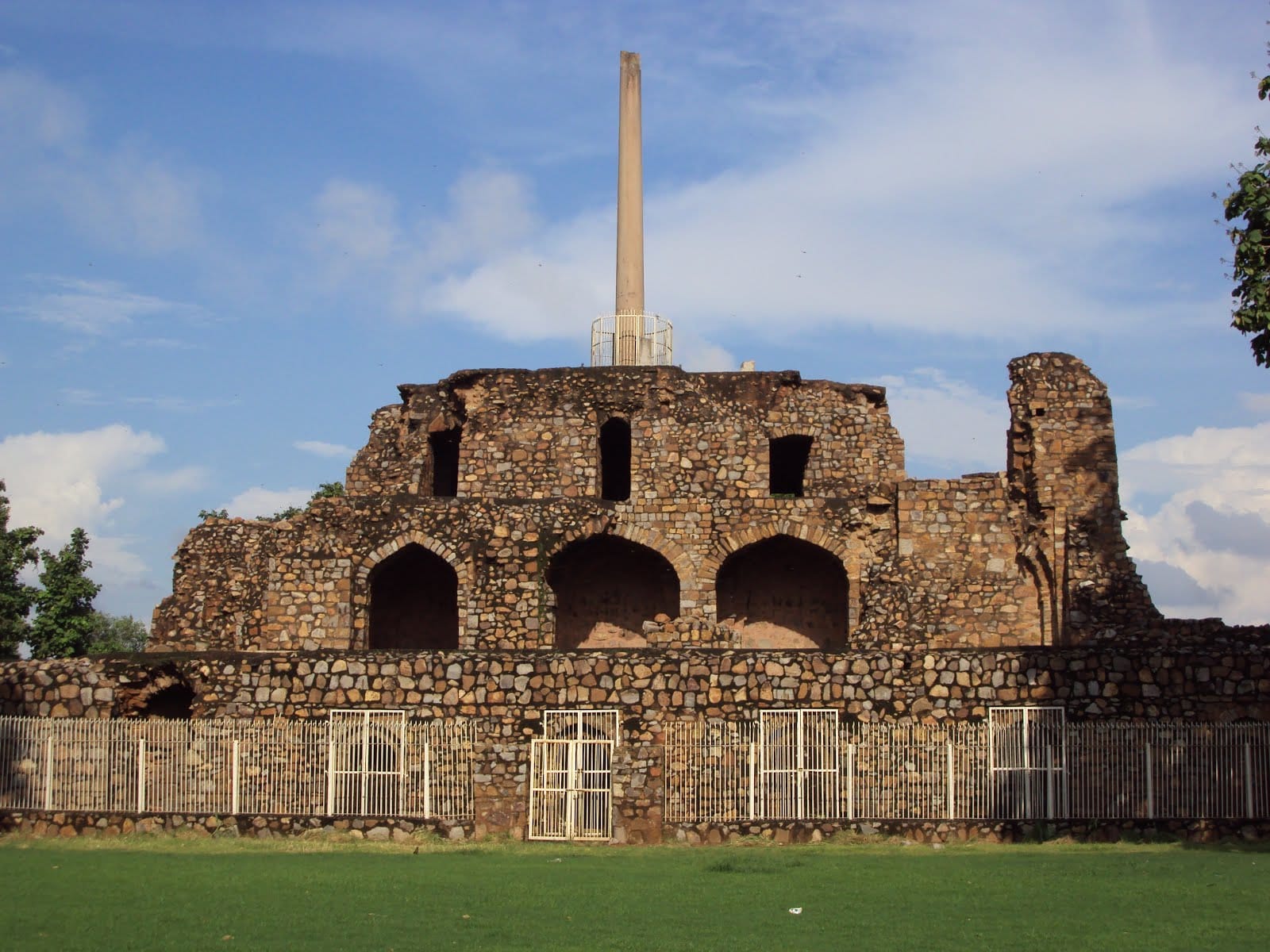
Topra Ashokan Pillar
Another notable attraction within the precincts of Feroz Shah Kotla Fort is the Topra Ashokan Pillar, an ancient monolithic pillar dating back to the 3rd century BCE. Originally erected by Emperor Ashoka, the pillar is one amongst several of its kind that live on as a reminder of his patronage of Buddhism and his efforts to propagate his edicts throughout the Indian subcontinent. The pillar, made of polished sandstone, stands at an impressive height of over 13 meters and bears inscriptions in Brahmi script, detailing Ashoka's teachings and moral principles.
The Topra Ashokan Pillar holds great historical and archaeological significance, providing valuable insights into the political, religious, and cultural landscape of ancient India. It was relocated to Feroz Shah Kotla Fort from Ambala at the behest of Feroz Shah in 1357. James Prinsep, an English scholar, provided the translation of its inscription in the mid-18th century.
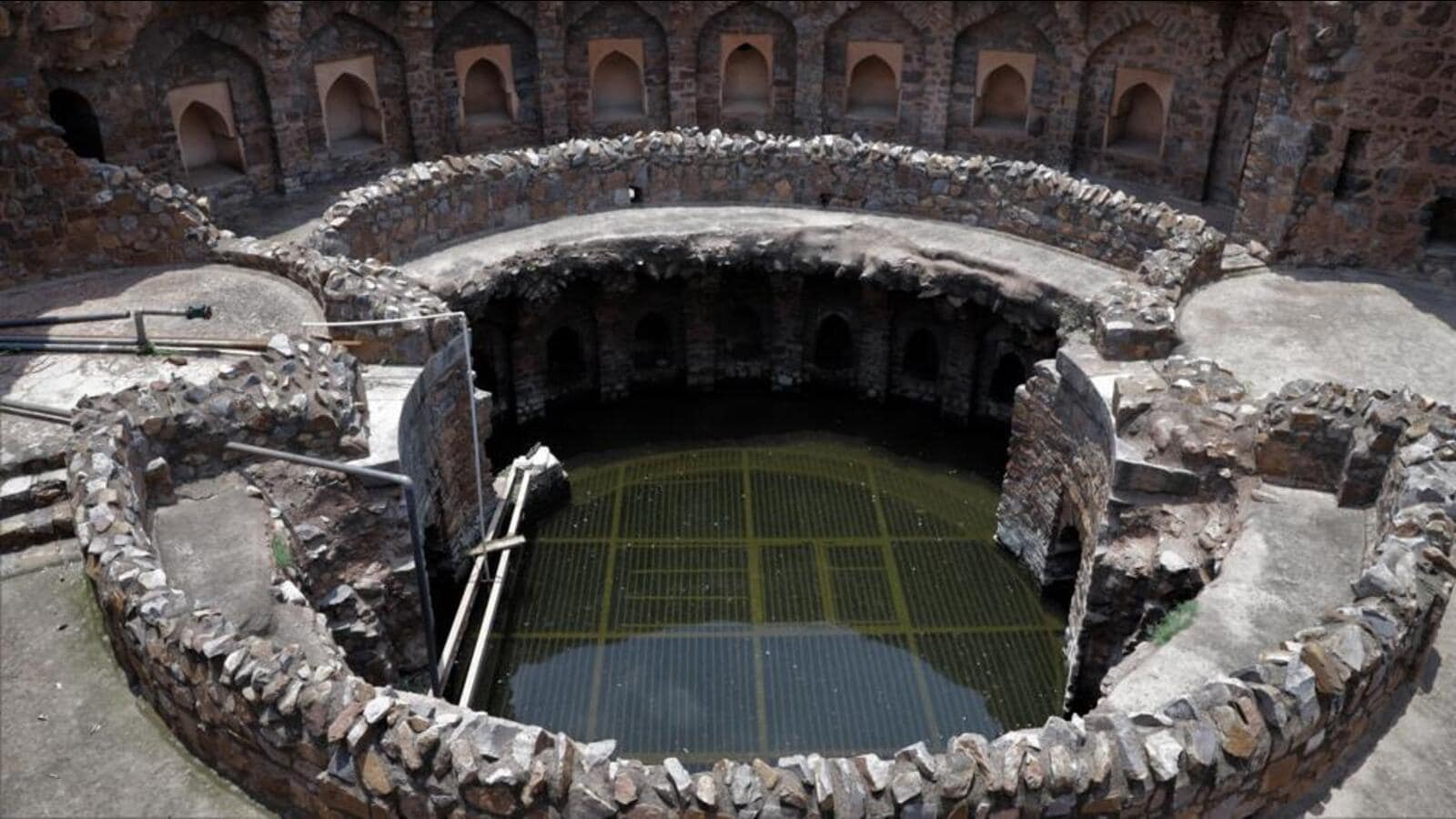
Baoli
In addition to its architectural splendors and historical relics, Feroz Shah Kotla Fort is also renowned for its Baoli, or stepwell, a traditional water harvesting structure that was to be found in medieval India. The Baoli, the biggest in Delhi, is located within the fort complex. It served as a vital source of water for the residents of Ferozabad, ensuring a reliable supply of water during times of drought and scarcity. Constructed with precision and ingenuity, the Baoli comprises a series of steps leading down to a reservoir, where rainwater and runoff water were collected and stored for domestic and agricultural use.
The design of the Baoli reflects the sophisticated hydraulic engineering techniques employed by medieval architects, who devised innovative solutions to harness and conserve water resources in arid regions. The stepped architecture of the Baoli not only facilitated the extraction of water but also provided a cool and shaded retreat for tired travellers and pilgrims.
Feroz Shah Kotla Fort stands as a beacon of India's glorious past, embodying the architectural, cultural, and historical legacy of bygone eras. In the pre-independence era, the fort played host to many a musical performances and post-independence, it was the location where Ebrahim Alkazi's Andha Yug was stages. From its beginnings as a medieval fortress to its transformation into a cultural landmark, the fort has endured the test of time, bearing witness to the rise and fall of empires and the march of progress.
Nearby Attractions
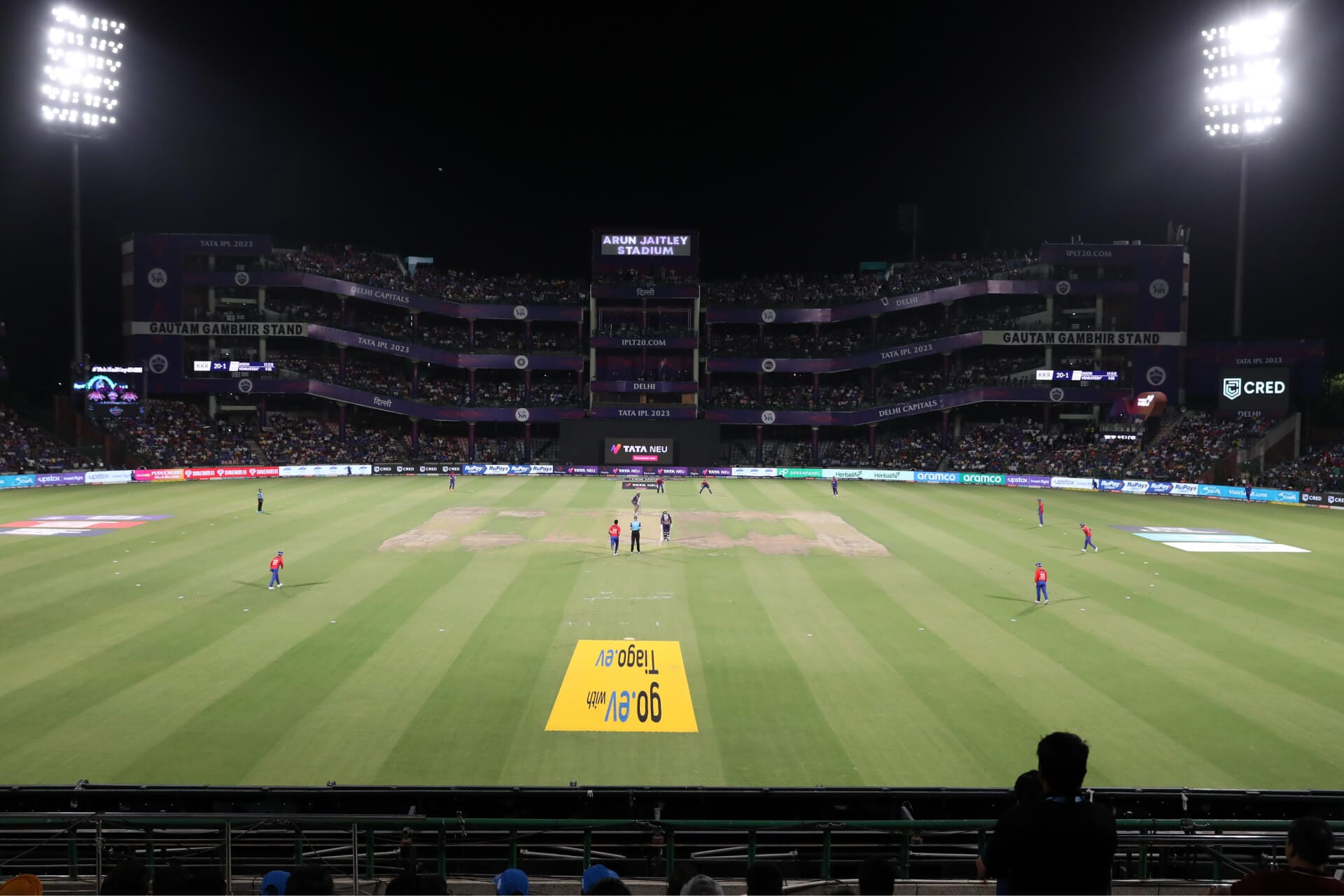
Feroze Shah Kotla/Arun Jaitley Stadium
Arun Jaitley Stadium, formerly known as Feroz Shah Kotla Stadium, is situated right next to the Feroz Shah Kotla Fort and has played a pivotal role in shaping the nation's sporting landscape and has hosted countless memorable cricket matches. Its origins of Arun Jaitley Stadium can be traced back to the early 20th century when cricket enthusiasts in Delhi felt the need for a dedicated venue to host local matches and tournaments. In 1883, the Kotla Cricket Club was established, laying the foundation for organized cricket in the region.
Over the years, the club's popularity grew, prompting the construction of a rudimentary stadium at the site of the historic Feroz Shah Kotla Fort. The stadium underwent several renovations and expansions over the decades, with significant upgrades in infrastructure and facilities to meet international standards. In 1948, Feroz Shah Kotla Stadium hosted its first Test match between India and West Indies, marking a milestone in its journey towards becoming one of India's premier cricketing venues. Over the years, the stadium witnessed numerous historic moments, including landmark victories by the Indian cricket team and memorable performances by legendary players.
The Delhi and District Cricket Association (DDCA) announced the renaming of Feroz Shah Kotla Stadium in honour of Arun Jaitley, former President of the DDCA, a stalwart of Indian politics and a passionate cricket aficionado. Today, it stands proud as the second oldest stadium in India and every year in the months of March, April and May, plays host to Delhi's IPL Franchise, the Delhi Capitals.

Shanti Van
Shanti Van, nestled amidst the serene surroundings near Raj Ghat in Delhi, serves as a tranquil sanctuary and the spot where Jawaharlal Nehru, India's first Prime Minister was cremated. Shanti Van holds profound significance as a memorial dedicated to Nehru's memory and his enduring contributions to the nation. Nehru's death left the nation grieving and mourning the loss of its beloved leader, affectionately referred to as "Chacha Nehru." Shanti Van serves as a symbol of India's pluralistic ethos and its commitment to secularism, democracy, and social justice. The memorial has hosted numerous dignitaries, world leaders, and luminaries from around the world, who have paid homage to Nehru's legacy and drawn inspiration from his vision of a modern, progressive India.
Shakti Sthal
Shakti Sthal, situated in Delhi, serves as a poignant homage to one of India's most influential leaders, Indira Gandhi. stands as a testament to Gandhi's indomitable spirit. It was established in the aftermath of the tragic assassination of Indira Gandhi on October 31, 1984, by her own bodyguards. The nation was plunged into mourning, and there was an overwhelming outpouring of grief and solidarity from millions who revered Gandhi as a visionary leader and an emblem of strength and resilience. The site chosen for the memorial, amidst lush greenery near Raj Ghat and the Yamuna River, was imbued with historical and cultural significance, providing a serene and contemplative setting for visitors to pay their respects.
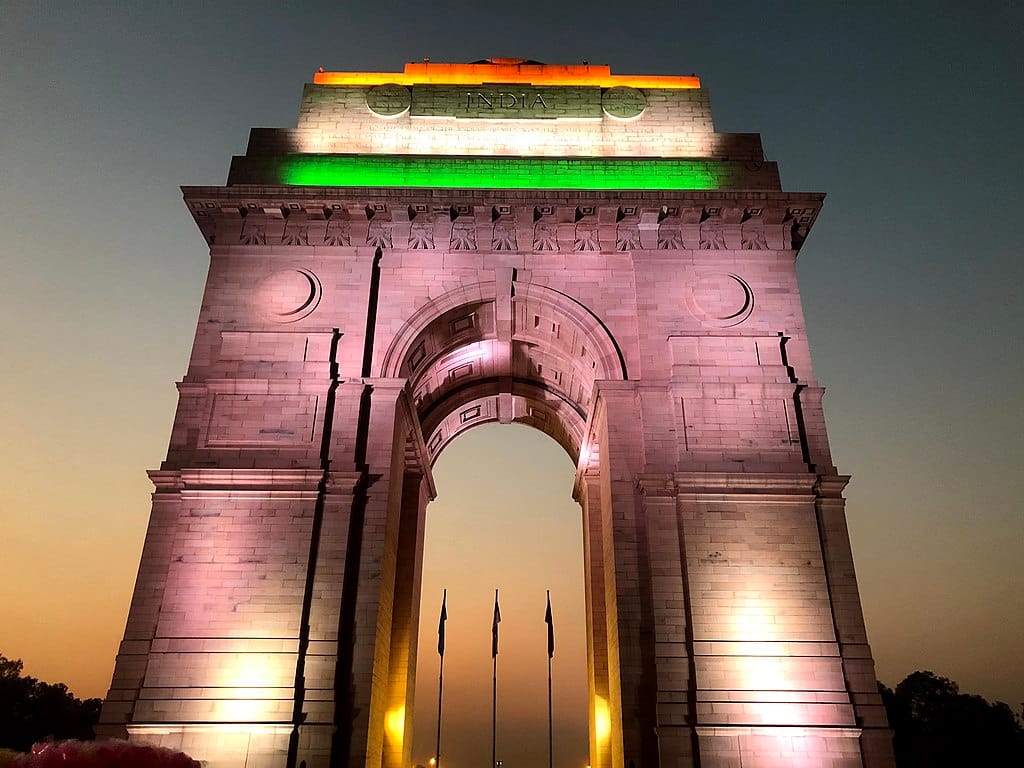
India Gate
India Gate, an iconic monument located in the heart of New Delhi, stands as a symbol of national pride, sacrifice, and remembrance. Designed by Sir Edwin Lutyens and completed in 1931, India Gate serves as a memorial to the Indian soldiers who lost their lives during 1914 and 1921 in World War I. Standing at a height of 42 meters, India Gate is a majestic archway inscribed with the names of over 13,000 soldiers from the Indian Army who made the ultimate sacrifice in service to their country. Surrounding India Gate is a sprawling expanse of lush green lawns known as the India Gate Lawns or Rajpath. It is the venue of the Annual Republic Day parade as well, and on other days, it is full of various food beverage and ice-cream vendors.
Connaught Place
Connaught Place, colloquially known as CP, is the commercial hub of New Delhi. Designed by British architect Robert Tor Russell in the early 20th century, it is characterized by its iconic white Georgian-style buildings arranged in concentric circles. CP is divided into inner and outer circles, with intricate artery like roads connecting it to various parts of the city in all directions. Connaught Place is not only a shopping paradise but also a landmark in itself.
Food Near Feroz Shah Kotla Fort
Chandni Chowk
Chandni Chowk is a bustling market in Old Delhi. Amidst its labyrinthine lanes, numerous iconic restaurants offer a culinary journey through Indian flavors. Karim's, a legendary eatery established in 1913, tantalizes taste buds with its Mughlai delicacies like kebabs and biryanis. The Mohabbat ka Sharbat is a must-have during summers, while the Shahi Tukda found here is hard to beat. Ghantewala, dating back to 1790, tempts with its mouthwatering sweets, especially the iconic Sohan Halwa. Al-Jawahar is famous for its meat-based curries, whereas Qureshi Kebab Corner serves some of the most delicious and rich seekh kebabs you’ll ever have. Chandni Chowk's gastronomic heritage calls out to food enthusiasts from far and wide.
Chor Bizarre Daryaganj
Chor Bizarre is a renowned restaurant located in Daryaganj which serves Kashmiri specialties like Rogan Josh and Dum Aloo and their signature dishes include Nalli Nihari, Butter Chicken, and Paneer Tikka, each prepared with authentic spices and flavors.

Parsi Anjuman
The Parsi Anjuman Restaurant located on Bahadur Shah Zafar Marg in Delhi features an enticing selection of dishes, including iconic Parsi specialties like Dhansak, Patra Ni Machhi, Sali Boti, and Berry Pulao and classic Parsi snacks like Kheema Pattice, Papeta Par Eeda, and Mutton Cutlets, followed by decadent desserts such as Lagan Nu Custard and Ravo.
Transport Options
Transport options to Feroz Shah Kotla Fort in Delhi, India, are varied, owing to its central location within the city. Visitors can choose from a range of convenient transportation modes to reach the fort:
The Delhi Metro is one of the most efficient and convenient ways to reach Feroz Shah Kotla Fort. The nearest metro station to the fort is the Delhi Gate Metro Station on the violet line, or if you are looking to avoid rush, you could get off at the next station, i.e., ITO Metro station and hitch an e-rickshaw to the fort. If you want to take the bus, consider the following routes that go through the Express Building Bus Stop, which is located just a few hundred metres away from the fort- 274, 334, 419LSTL, 429, 502, 621, 770A, 790, 793, 793B.
Auto-rickshaws and taxis are readily available throughout Delhi and provide a convenient option for reaching Feroz Shah Kotla Fort. Visitors can hire these modes of transport from any part of the city or use ride-hailing apps. Private Vehicles are discouraged due to the lack of parking space nearby
Tickets and Timings
Feroz Shah Kotla Fort is generally open to visitors from 8:30AM to 7:00 PM on all seven days of the week. The entry to Feroz Shah Kotla Fort is INR 5 for Indian visitors while foreign nationals are expected to cough up INR 500. It's recommended to carry a valid ID proof while visiting the fort, especially for international visitors. Additionally, if you're planning to hire a guide or avail of any additional services, such as photography permits, it's advisable to inquire about the fees so as to avoid attracting any fines.

Comments ()